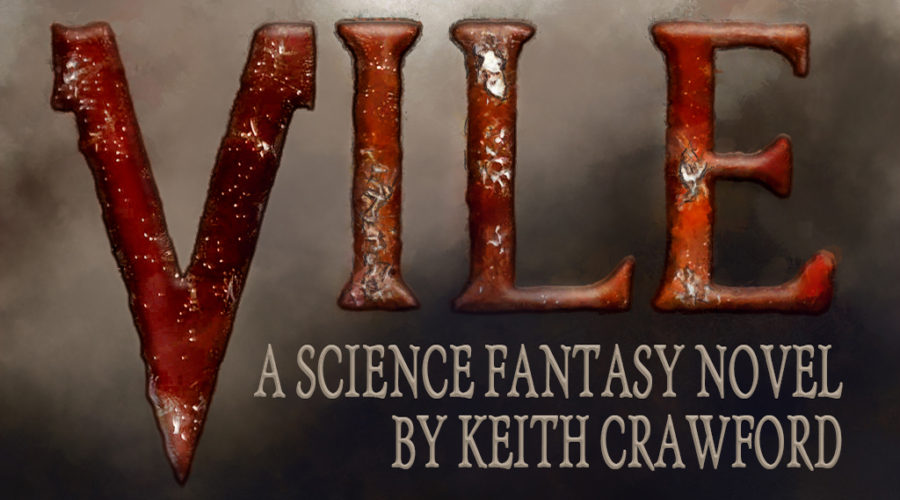Here it is. After four years of work my first novel is now available, with a cover designed by the marvellous Claire Peacey of https://cpeacey.wixsite.com/autumnsky. If you’d like to get your hands on some goodies and help me promote the book, check out the Kickstarter at https://www.kickstarter.com/projects/vile/vile. And here’s the beautiful cover she made for me:

In this article I’m not just showing off my new book. I want to share 8 simple, practical tips I learned from self-publishing my book. I’m sure I’ll learn more lessons in the future. But these were things I found out by doing it, and maybe they’ll be useful to you.
Vile is my new Science Fantasy novel, a dark, low fantasy about Elianor Paine, who has six days to subvert her investigation, supplant war hero Lord Arbalest Vile and kick off a revolution before her royalist master discovers the truth and has her killed. Here are some things I learned in the journey from a word file on my computer to a real live buyable book.
You can find out much more about it here.
I published on Amazon and am using Kickstarter to help promote my book and give it the platform I hope it deserves. It turns out that both Amazon KDP and Kindle are excellent, if you let them be.
1. You CAN do clever stuff with other e-book designers, but the beta version of “Kindle Create” from Amazon is really very good if you just want a simple, clean e-book. After faffing around for hours using Notepad++ and a bunch of html, I gave up, imported my document into Kindle Create and the rest took me about an hour. Unless you have a very specific vision, use the solution Amazon provide.
2. You’ll upload your paperback as a PDF. Amazon offer several different templates that you can download in word/your word processor of choice and, frankly, they’re excellent. Just cut and paste your book into the template and tweak until you’re pleased.
3. When you upload your eBook/paperback, they’ll go onto something called your “bookshelf”, from which you can make all sorts of revisions – even after publication. So, it is best to get started early and get a feel for how it works, rather than trying to have everything perfect before you start using amazon. Give yourself plenty of time!
4. Use a professional proof-reader, copyeditor and cover artist. It makes a huge difference. I write clean script (yes, yes, I know, apart from on my blog). But I was horrified (and mildly relieved because now I could correct them) when I saw how many errors there were in what I had considered my “finished” manuscript. And my proof-editor said mine was a good document! So, hire a professional, or look like an amateur. Your call.
5. Making an audiobook was a very good idea. I don’t know if it’ll sell – hell, I don’t know if I’ll ever finishing editing – but the process of reading the whole book into a microphone helped me find about one error every two chapters. This was after professional proofreading, copy-editing, and many, many careful revisions on my part. I have all the gear from my podcast, but a decent microphone for about £50, a quiet room and a phone would probably do the job.
6. When you hit publish on amazon, it takes several days to populate the book. The e-book will probably go up quickly (less than 12 hours for mine), but without all the art and text, which slowly caught up. Then a day or two later the paperback, with the warning that it would take a bit longer for amazon to link the two together. Long story short: don’t set yourself up for a launch event on the day that you hit “publish” on Amazon – it’s going to take at least a week to get it all together. Which is brilliant, but good to know in advance.
7. If you’re running a Kickstarter to support your book, take note that it takes them a week or two to send you the money (should your campaign succeed). The mistake I made here was promising people I’d send T-Shirts/Books/Shinies/Run launch events at a time BEFORE I will have received the money from Kickstarter. While I’m dusting off my credit card and feeling like an idiot, don’t you make the same mistake: give yourself plenty of time (at least two weeks) between the end of your Kickstarter and when you’ll have to spend any money.
8. You ARE going to check the Kickstarter every five minutes. Make sure to make space for your mental health. You’ll have done a huge amount of work to get to the publication point, and now you must spend an equally large amount of time asking people to buy your book. Go buy yourself a cake or something. Watch a movie. Your book is in print! This part is fun, so make sure it’s fun.
Oh, and if you’ve enjoyed this article or any of my other work, please do check out the Kickstarter and share it with your friends. This is a massive deal for me. Help me make the dream come true.



